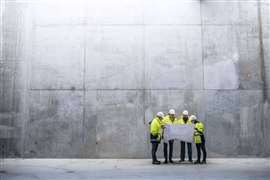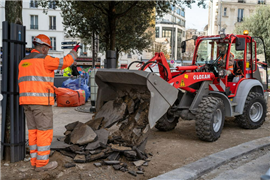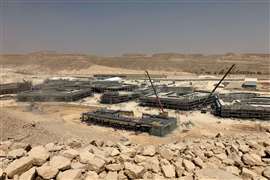US bridge comes in a "backpack"
01 September 2010

A new bridge in Belfast, Maine, US is being constructed using concrete-filled, carbon fibre tubes developed at the University of Maine's AEWC Advanced Structures and Composites Center.
Known as a "bridge-in-a-backpack" because individual, lightweight components can be moved without a crane, the technology uses flexible, carbon fibre tubes inflated with air, cured with a resin and then filled with concrete on-site to form the bridge's main structural elements.
AEWC, formerly known as the Advanced Engineered Wood Composite Center, began developing the technology in 2001. In 2009, the University of Maine licensed the "bridge-in-a-backpack" technology to Advanced Infrastructure Technologies (AIT).
Construction process
Constructing the bridge is a relatively simple process, according to AIT. First the arches are shaped to the required geometry. Composite layers infused with resin (see picture 1). Then these lightweight arches, which require no formwork, are placed in position either manually or using a small capacity boom truck-mounted crane (see picture 2).
A durable composite bridge deck is then attached and the arches filled with concrete, with no rebar required, although some sites have required decking reinforcement (see picture 3). Lastly, the fill is compacted on top of decking and gravel (sub-base) and road surface, such as asphalt, is added (see picture 4).
According to AIT the composite bridge system lowers construction costs, extends a bridge's structural lifespan by 100 years or more, and is a greener alternative to concrete and steel construction.
AIT provides conceptual and design services, fabrication of the composite superstructure elements and installation oversight.
All designs, the company adds, are engineered to exceed AASHTO (American Association of State Highway and Transportation Officials) load standards for single span bridges from 25 to 70 ft (7.62 to 21.34 m) and multi-span designs exceeding 800 ft (243.84 m).
Advanced composites.
AIT says the system uses a composite exoskeleton to fortify the concrete superstructure. This adds significant strength, durability and protects the concrete from corrosion.
The fabrication of the superstructure elements is a proprietary process that fuses several layers (including carbon fibre) with resin to create the composite material. The exact blend is engineered to optimize the efficiency of the bridge design.
The bridge is one of three currently under construction using the new technology, all of which are being funded by the Maine Department of Transport (MDOT) thanks to a US$ 6 million grant.
To contact AIT CLICK HERE
STAY CONNECTED


Receive the information you need when you need it through our world-leading magazines, newsletters and daily briefings.
CONNECT WITH THE TEAM










